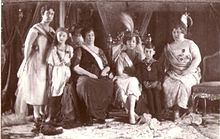Şehzade Mehmed Ertuğrul (original) (raw)
From Wikipedia, the free encyclopedia
Ottoman prince (1912–1944)
| Şehzade Mehmed Ertuğrul | |
|---|---|
| Born | 5 November 1912Vahdettin Pavilion, Çengelköy, Constantinople, Ottoman Empire (present-day Istanbul, Turkey) |
| Died | 2 July 1944(1944-07-02) (aged 31)Cairo, Kingdom of Egypt |
| Burial | Abbas Hilmi Pasha Mausoleum, Cairo, Egypt |
| NamesTurkish: Şehzade Mehmed ErtuğrulOttoman Turkish: شهزاده محمد ارطغرل | |
| Dynasty | Ottoman |
| Father | Mehmed VI |
| Mother | Müveddet Kadın |
| Religion | Sunni Islam |
Şehzade Mehmed Ertuğrul Efendi (Ottoman Turkish: شهزاده محمد ارطغرل; 5 November 1912 – 2 July 1944) was an Ottoman prince, the last child and only son of Sultan Mehmed VI, the last sultan of the Ottoman Empire. His mother was Mehmed's second consort Müveddet Kadın.
Ertuğrul (second from right) at her half-sister Sabiha's (third from right) wedding, 29 April 1920
Şehzade Mehmed Ertuğrul was born on 5 November 1912[1] in his father's mansion in Çengelköy.[2] His father was Mehmed VI, son of Abdulmejid I and Gülistu Kadın.[3] His mother was Müveddet Kadın,[4] daughter of Kato Davut Çıhcı and Ayşe Hanım.[5] He was the only son and fourth and last child born to his father and the only child of his mother.[3] Ertuğrul was educated privately. His tutor was Kaymakam Emin Bey, who taught literature in the imperial school.[6]
When his father left Turkey on 17 November 1922, he only took Ertuğrul with him, and a small number of Palace officials with him.[7][8][9] The other members of the family, including his mother, later joined them in Sanremo in 1924. He and his mother were assigned one floor in his father's villa. After his father's death in 1926, Ertuğrul, who was then fourteen years old, left his mother, and went to live with elder half-sister, Sabiha Sultan.[2]
His mother meanwhile went to Egypt, married a Turk there, and then taking the advantage of the law allowing the widows of the sultans to return to Turkey, moved back to Istanbul, and settled in the mansion in Çengelköy, which she jointly owned. Ertuğrul always refused to accept his mother's second marriage, and never saw her again. He was then enrolled in a boarding school in Grasse, where he studied for several years.[2]
Ertuğrul [10]
Ertuğrul died at the age of thirty-one at Cairo, Egypt on 2 July 1944. He had fallen sick during a tennis match, and died few hours later[11][12] of an unidentified illness.[13] He was buried in the mausoleum of Abbas Hilmi Pasa, Cairo. His death devastated his mother, who fell into depression and never recovered.[3]
- ^ Bardakçı 2017, pp. xvi, 94.
- ^ a b c Bardakçı 2017, p. 94.
- ^ a b c Adra, Jamil (2005). Genealogy of the Imperial Ottoman Family 2005. pp. 35–36.
- ^ Bardakçı 2006, p. 164.
- ^ Açba, Leyla (2004). Bir Çerkes prensesinin harem hatıraları. L & M. p. 74. ISBN 978-9-756-49131-7.
- ^ Kırpık, Cevdet (2010). II. Meşrutiyet'ten Sonra Şehzade Eğitiminde Değişim. SDÜ Fen Edebiyat Fakültesi. pp. 99–130. Retrieved 12 April 2021.
- ^ Brookes, Douglas Scott (2010). The Concubine, the Princess, and the Teacher: Voices from the Ottoman Harem. University of Texas Press. pp. 271 n. 68. ISBN 978-0-292-78335-5.
- ^ Kadir Misiroǧlu (1974). Osmanoǧlullari'nin drami: elli gurbet yili (1924-1974). Sebil Yayinevi. p. 199.
- ^ Bardakçı 2006, p. 39.
- ^ "MAADI'S OTTOMANS". egy.com. Retrieved 12 April 2021.
- ^ Bardakçı 2006, p. 112.
- ^ Bardakçı 2017, p. xvi.
- ^ Bardakçı 2017, p. 10.
- ^ Salnâme-i Devlet-i Âliyye-i Osmanîyye, 1333-1334 Sene-i Maliye, 68. Sene. Hilal Matbaası. 1918. pp. 68–69.
- Bardakçı, Murat (2017). Neslishah: The Last Ottoman Princess. American University in Cairo Press. doi:10.2307/j.ctv2ks70vz. ISBN 978-9-774-16837-6. JSTOR j.ctv2ks70vz.
- Bardakçı, Murat (2006). Son Osmanlılar: Osmanlı hanedanının sürgün ve miras öyküsü. Hürriyet Gazetecilik ve Matbaacılık A.Ş.
